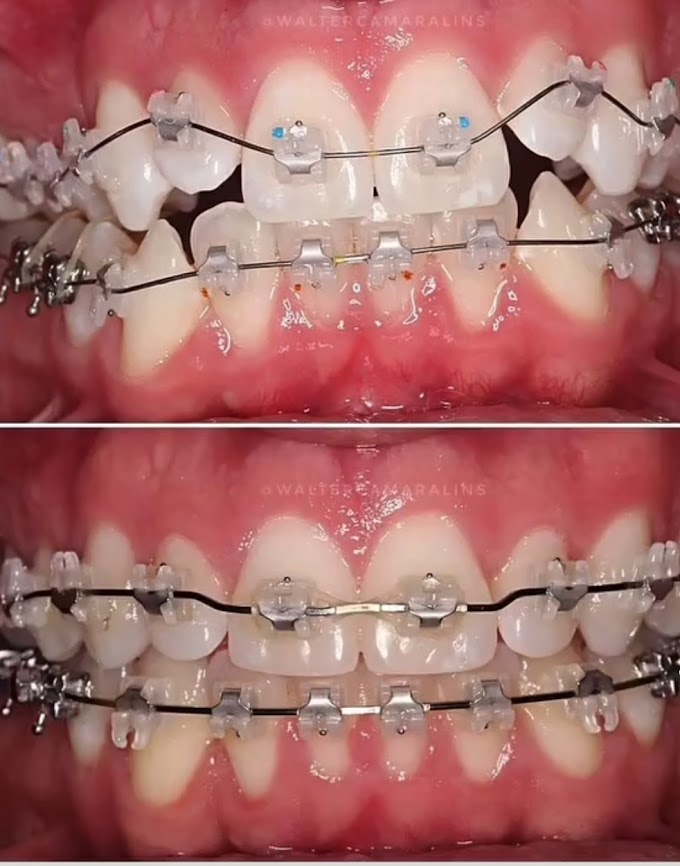An 8-year-old girl was brought to the orthodontic clinic with the chief complaint of "missing front tooth". She was skeletal class I with early mixed dentition and Class II molar relationship. Her palate was constricted-V shaped with left unilateral crossbite, missing left central incisor. ALD was -5.8 mm in maxilla and -1.5 mm in mandible. Incisors relationship was class II div II type B with slightly proclined lower incisors. Radiographic evaluation showed horizontally impacted left upper central incisor in nasal floor. There was a history of deciduous incisors trauma at 2 years of age.
a) What are the objectives to be considered for the management of this case?
b) What are treatment alternatives for this patient?
Answer:
In assessing the orthodontic management of this patient with a missing central incisor and specific dental and skeletal characteristics, we can approach the questions as follows:
### a) Objectives to be Considered for the Management of This Case:
1. **Restoration of Aesthetic and Functional Occlusion:**
- Address the aesthetic concern associated with the missing left central incisor.
- Restore normal function including speech and mastication, ensuring that the remaining teeth maintain appropriate function.
2. **Management of the Impacted Tooth:**
- Evaluate the possibility of exposing and bringing down the impacted left upper central incisor.
- Decide whether it is feasible to orthodontically guide the impacted tooth into proper alignment.
3. **Correction of Skeletal and Dental Relationships:**
- Maintain the skeletal Class I relationship while managing the Class II molar relationship.
- Evaluate the Class II div II incisor relationship and consider if any corrections are necessary for better alignment and occlusion.
4. **Addressing the Constricted Palate:**
- Consider expansion of the V-shaped constricted palate to facilitate space for the impacted incisor and improve arch form.
5. **Dental Arch Length Discrepancy:**
- Address the arch length discrepancy (ALD) of -5.8 mm in the maxilla that may contribute to crowding and space issues.
6. **Oral Health Monitoring:**
- Continuous assessment of periodontal health and maintenance of dental hygiene throughout the treatment process.
7. **Long-term Planning:**
- Plan for future prosthetic solutions should the impacted incisor remain inoperative or if extraction becomes necessary.
- Assess potential implications on the eruptive patterns of adjacent teeth.
8. **Patient-Centric Approach:**
- Engage the patient and family in treatment planning, ensuring their concerns about aesthetics and function are addressed.
- Ensure clear communication regarding treatment options, timelines, and expected outcomes.
### b) Treatment Alternatives for This Patient:
1. **Orthodontic Exposure and Alignment:**
- **Surgical Exposure:** A surgical procedure could be done to expose the impacted left central incisor, followed by orthodontic management to align it properly in the dental arch.
- **Brackets and Traction:** Use orthodontic brackets on the impacted tooth and apply light forces via elastics or other traction devices.
2. **Replacement Options if Tooth Cannot Erupt:**
- **Space Maintainers:** If the impacted central incisor cannot be managed, the space can be maintained with a fixed or removable space maintainer until the growth period is complete.
- **Prosthetic Replacement:** Consider a future prosthetic solution such as a dental implant or a fixed bridge once the growth is completed.
3. **Palatal Expansion:**
- **Rapid Palatal Expansion (RPE):** Implement an RPE appliance to correct the constricted V-shape of the palate, which can create more space for the impacted tooth or teeth in general.
4. **Comprehensive Orthodontic Treatment:**
- Initiate a full orthodontic treatment plan that includes fixed appliances to improve the overall alignment of the incisors and molars and address the crossbite issue.
5. **Monitoring and Regular Re-evaluation:**
- Continuous monitoring of the dental eruptive patterns and making necessary adjustments to the treatment plan based on the progression.
6. **Interceptive Orthodontics:**
- Interceptive treatments may be necessary to manage the Class II div II relationship and take advantage of the mixed dentition stage.
7. **Interdisciplinary Approach:**
- Collaboration with oral surgeons and possibly pediatric dentists for comprehensive management of the impacted tooth and overall dental health.
In summary, the management of this case requires careful assessment and a multi-faceted approach that addresses both the aesthetic and functional concerns, while also accounting for the unique dental and skeletal characteristics of the patient. Regular communication with the patient and family throughout the treatment process will be essential to ensure a successful outcome.



